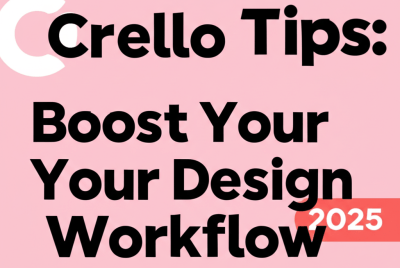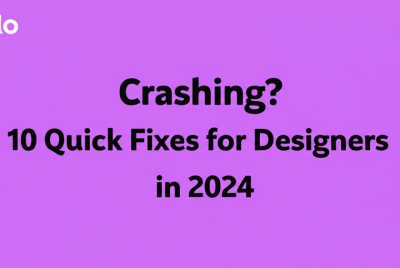Thinking of diving into UI/UX design but feeling a bit lost on where to start? You’re in the right spot! Here’s what you’ll find in this guide to getting started with Figma:
- What Figma is and why it’s a game-changer for new designers.
- How to quickly get familiar with Figma’s main tools and features.
- A simple, hands-on tutorial to create your very first UI element.
- Techniques to take your UI designs to the next level.
- Tips for continuing your journey from a beginner to a pro in Figma.
Figma has quickly become the go-to tool for collaborative design, prototyping, and so much more. Learning Figma for beginners is a clear path to unlocking incredible creative potential, whether you’re totally new to design or moving over from another tool.
At its heart, Figma is a powerful, cloud-based design tool. It lets you create, prototype, and collaborate on user interface (UI) designs right in your web browser. For Figma for beginners, getting started is super easy: sign up for a free account, explore the intuitive interface, and play around with basic tools like frames, shapes, and text. Its real-time collaboration feature means multiple designers can work on the same file at once, making teamwork incredibly efficient.
What exactly is Figma, and why is it perfect for graphic design beginners?
Figma has truly changed the design world by making professional-grade design tools accessible to everyone. Unlike old-school desktop software that often demands specific operating systems and hefty installations, Figma runs entirely in your browser. This means you can work on your projects from any device with an internet connection—your desktop, laptop, or even a tablet. This amazing accessibility, combined with its robust and constantly improving features, makes it an ideal choice for Figma for beginners who want to quickly learn Figma without the hassle of expensive software or long setup times.
Here’s why Figma shines as a top choice for designers, especially those just starting:
- Browser-Based Convenience: No installations needed, automatic updates, and it works across all platforms. You’re always using the latest features.
- Real-time Collaboration: Work smoothly with teammates, clients, or mentors in a shared space, seeing changes instantly. This is a huge boost for any graphic design project.
- Integrated Prototyping: Turn your static designs into interactive prototypes that simulate user flows, making testing and getting feedback much easier.
- Comprehensive Version History: Never worry about losing work! Figma automatically saves versions, so you can track changes and go back to earlier iterations effortlessly.
- Vibrant Community Resources: Dive into a huge library of plugins, templates, and design systems shared by the global Figma community, speeding up your learning and workflow.
Many designers often compare various design tools to find the best fit. While tools like Sketch have been popular for years, Figma’s web-based approach and superior collaborative features offer clear advantages for today’s design teams. If you’re weighing your options, our comparison of Figma vs Sketch can help you understand how they stack up.
What are the foundational steps to learn Figma basics for new designers?
Getting a handle on Figma basics is absolutely key for anyone new to the platform. While the interface might look a bit busy at first, it’s organized very logically, so you’ll pick it up surprisingly fast. On the left, you’ll find the Layers panel, showing all your design elements, and the Assets panel, where components and styles live. On the right, the Properties panel lets you customize selected elements, and the Prototype tab helps you define interactions and animations. The big central canvas? That’s your creative space where all your designs come to life.
Here’s a quick overview of essential elements and actions every Figma for beginners user should know:
- Frames: Think of these as your artboards or canvases—like individual screens for an app, pages for a website, or even single components. Just press ‘F’ to create them.
- Shapes: These are the fundamental building blocks of any design. Use rectangles (‘R’), circles (‘O’), lines (‘L’), and polygons to build your UI elements.
- Text Tool: Press ‘T’ to add and style your typography, which is crucial for labels, headings, and body content.
- Pen Tool: Master the ‘P’ key for crafting custom vector shapes, icons, and detailed illustrations. Learn more about vector image file types to understand their power.
- Components: These are reusable UI elements—buttons, navigation bars, cards—that help maintain consistency across your design and significantly speed up your workflow.
- Colors & Styles: Learn to apply and manage colors, gradients, and text styles to create a unified visual language. Dive into RGB and CMYK to understand color models better.
Becoming comfortable with these basic tools will empower you to quickly create your first designs and articulate your ideas visually. If you’re coming from other design tools, you might find Figma’s approach to features like auto layout or components more streamlined. For a wider view on design software, our Canva vs Figma comparison might be insightful, especially if you’re looking at tools for different types of graphic design work beyond just UI/UX.
Can I learn Figma UI design with a simple button tutorial?
Absolutely! Ready to put your new knowledge into action? This hands-on Figma tutorial will walk you through creating a basic interactive button, a common element in any modern Figma UI design. This exercise is designed to give you immediate experience with Figma’s core tools.
Follow these steps to create your first functional button:
- Create a Frame: Press ‘F’ on your keyboard and draw a small rectangle on your canvas. This frame will be the screen or container for your button.
- Draw a Rectangle for the Button: Next, press ‘R’ and draw a smaller rectangle inside your new frame. This will be the button’s visual shape. Adjust its size and position as you like.
- Apply a Fill Color: With the button rectangle selected, go to the ‘Fill’ section in the right sidebar. Click the color swatch to open the color picker and choose a nice color for your button.
- Add Descriptive Text: Press ‘T’ to use the text tool. Click inside your button rectangle and type text like “Submit” or “Click Here”.
- Style Your Text: While the text is selected, use the ‘Text’ section in the right sidebar to change its font, size, weight, and color. Make sure it’s easy to read and looks good with your button.
- Center Elements Precisely: Select both the button rectangle and the text layer. Use the alignment tools (they look like alignment guides) in the right sidebar to center them both horizontally and vertically within each other.
- Group for Manageability: To treat your button as one item, select both the rectangle and the text. Then, press
Ctrl+G(Windows) orCmd+G(Mac) to group them. Now you can move and resize your button as a single, cohesive element.
This step-by-step process is a fantastic way to solidify your understanding of basic interactions and Figma’s intuitive nature. As you get more comfortable, you’ll discover many shortcuts and techniques to speed up your design process even more. For those looking to optimize their workflow, exploring various Figma tips can offer valuable insights and efficiency boosts.
What advanced Figma UI design techniques will elevate my projects?
Effective Figma UI design goes beyond simply drawing shapes and adding text. It truly involves understanding how users interact with interfaces and using Figma’s powerful features to create intuitive, engaging, and highly functional user experiences. Figma offers a robust set of tools specifically built for crafting high-fidelity mockups, comprehensive design systems, and dynamic, interactive prototypes.
Here are key tools and approaches for advanced UI design in Figma:
- Auto Layout: This is a game-changer for responsive design. Auto Layout lets you create frames that automatically resize and reflow their content based on changes to content or screen dimensions, making responsive design much simpler.
- Constraints: Define how elements inside a frame should behave when that frame is resized. This is vital for building adaptive layouts that look great on different screen sizes.
- Variants: An incredibly powerful feature for managing different states or versions of components (e.g., a default button, a hover state, a pressed state). Variants help you organize many similar components into a single, efficient component set, greatly enhancing your design system.
- Plugins & Widgets: Expand Figma’s native functionality with a huge ecosystem of third-party plugins and widgets. These can help with everything from generating placeholder content and spell-checking to importing icon sets and creating complex data visualizations.
- Prototyping & Interactions: Move past static screens. Figma’s prototyping tools allow you to define click, hover, and drag interactions, letting you create realistic user flows that can be tested and refined.
By smartly using these advanced features, you can efficiently move from static mockups to dynamic, interactive prototypes that not only look good but also accurately represent the intended user experience. This capability is crucial for faster iteration, getting more meaningful user feedback, and ultimately delivering superior design solutions.
How can I continue to learn Figma and become a proficient user?
Once you’ve confidently grasped the fundamentals covered in this Figma guide, the journey to becoming a truly proficient Figma user is both exciting and rewarding. There’s always more to learn Figma, from diving into advanced prototyping and intricate animations to mastering the creation and maintenance of extensive component libraries for large projects. We highly recommend actively exploring the vast Figma Community—it’s a goldmine where designers worldwide share files, innovative plugins, and expertly crafted templates.
Here’s how you can keep growing and developing your skills:
- Practice Consistently: Regular, hands-on practice is the most effective way to internalize concepts and refine your skills. Try recreating existing UIs or designing small personal projects.
- Explore Figma’s Plugin Ecosystem: Experiment with various plugins and widgets. They can dramatically boost your workflow, automate repetitive tasks, and open up new creative possibilities.
- Engage with the Figma Community: Join online forums, Discord servers, and local meetups. Learning from other designers, asking questions, and sharing your work are invaluable for growth.
- Undertake Advanced Tutorials and Courses: Once comfortable with the basics, seek out tutorials that explore more complex features like advanced prototyping, auto layout mastery, or building robust design systems.
- Contribute to Open Source Projects: Applying your skills to real-world projects, even small ones, gives you practical experience and helps build your portfolio.
This Figma guide has provided the essential groundwork, giving you the necessary tools and understanding. However, true depth of learning and mastery comes through active doing, continuous experimentation, and embracing challenges. Don’t hesitate to try new things, make mistakes (they’re fantastic learning opportunities!), and constantly look for ways to improve your designs and workflow.
Frequently Asked Questions about Figma for Beginners
Is Figma truly free for beginners to learn UI design?
Yes, Figma offers a very generous free tier that’s perfect for individuals and beginners to get started with most of its core features. With the free starter plan, you can create up to three Figma and FigJam files and access unlimited personal draft files, which is more than enough for learning and personal projects.
What are the essential hardware requirements to run Figma smoothly for graphic design?
Since Figma is primarily a browser-based application, your main requirements are a stable and reasonably fast internet connection and a modern web browser (like Google Chrome, Mozilla Firefox, Apple Safari, or Microsoft Edge). While it can run on most modern computers, having at least 8GB of RAM (16GB is recommended for larger projects) and a decent multi-core processor will ensure a smoother and more responsive design experience, especially when working with complex files or many assets. For optimizing performance, consider our guides on 8GB RAM for graphic design or 16GB RAM for graphic design.
Can Figma be used for general graphic design tasks, or is it strictly for UI/UX projects?
While Figma’s main focus and strength are definitely in UI/UX design—including interface design, prototyping, and design systems—its strong vector editing capabilities make it quite versatile. You can certainly use Figma for various general graphic design tasks, such as creating social media graphics, designing simple logos, crafting custom icons, and even basic illustrations. However, for highly specialized tasks like complex photo manipulation or print-ready layouts, dedicated software like Adobe Photoshop or Illustrator might still be more suitable. For comparisons with other tools, you might find our Photoshop vs CorelDraw article insightful.
How does Figma compare to other design tools when learning for the first time?
For Figma for beginners, it generally offers a much smoother onboarding experience compared to many traditional desktop design applications. Its browser-based nature eliminates installation hurdles, and its intuitive interface often feels less intimidating. The real-time collaboration feature is also a huge benefit for learning and getting feedback. While other tools have their strengths, Figma’s accessibility, strong community support, and continuous development make it an excellent starting point for new designers. For more on general design inspiration, check out our resources.
Key Takeaways for Your Figma Journey:
- Figma’s browser-based nature makes it incredibly accessible, removing barriers for new designers.
- Real-time collaboration and integrated prototyping accelerate your workflow and feedback loops.
- Mastering fundamental tools like Frames, Shapes, Text, and Components is your first step to creating compelling designs.
- Advanced features such as Auto Layout and Variants are crucial for scalable and responsive UI design.
- Continuous practice and engaging with the vibrant Figma community are essential for ongoing growth and proficiency.
Ready to transform your design ideas into reality? Dive into Figma today and unlock your creative potential!
Authoritative Resources:


